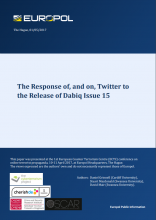The so-called Islamic State (IS) has a sophisticated media strategy (Winter 2017), an important part of which has been its English-language online magazine Dabiq. Launched in July 2014, a total of fifteen issues of Dabiq in the two years that followed. These issues were disseminated in a variety of ways, including archive sites (Bodo and Speckhard 2017), web forums and file-sharing networks (Gambhir 2016), the dark web (Stacey 2017), and even via an attempt to sell the freely available magazines for profit through the online retailer Amazon (Masi 2015). One of the most important forums for dissemination, however, was the social media platform Twitter (Bodo and Speckhard 2017; Gambhir 2016; Cunningham, Everton and Schroeder 2015; Shaheen 2015). Released in July 2016, the theme of Dabiq issue 15 was ‘Break the Cross’. After referring to a number of attacks that had occurred in the preceding weeks, the issue’s foreword called on ‘pagan Christians’, ‘liberalist secularists’ and ‘sceptical atheists’ to ‘recognize their Creator and submit to Him’. In addition to regular features, including ‘Among the believers are men’ and ‘In the words of the enemy’ (which, in this issue’ focussed on Pope Francis), and advertisements for other IS media, issue 15 contained an 18 page feature article, also titled ‘Break the Cross’. Arguing that the Bible does not display the three hallmarks of a true divine text, the article discusses the doctrine of the Trinity, whether Jesus was crucified, and whether Paul’s New Testament teachings are authentic (repeatedly stating that Paul was a known liar). It then seeks to establish the authenticity of the Prophet Muhammad, before asking Christians rhetorically: ‘O People of the Scripture, follow the truth from your Lord, whom you claim to love. Would you follow your parents and ancestors if you knew they were walking into a fire?’ and concluding ‘Know well that our fight will continue until you are defeated and submit to the rule of your Creator, or until we achieve martyrdom. Allah has made our mission to wage war against disbelief until it ceases to exist, as he has ordered us to kill all pagans wherever they are found’. Drawing on an original dataset, in this article we examine the response to the release of Dabiq issue 15 on Twitter. We examine the response in two respects: first, the response from Twitter itself, in terms of suspension activity; and, second, the response from other users, in terms of their engagement with posts disseminating the new issue. Before presenting our findings, we begin by offering an overview of our methodology.
